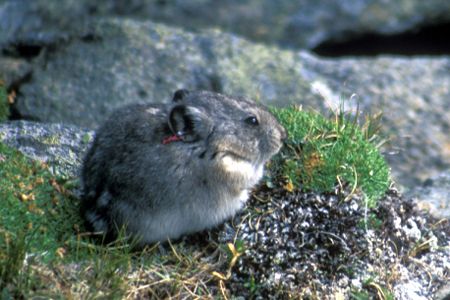Caterpillars' 'Leftovers' Delicious To Mountain Mammal

(ISNS) -- University of Alberta researchers recently discovered a special relationship between mammals that are roughly the size of hamsters, called collared pikas, and Arctic woolly-bear moth caterpillars. The two animals share a food source in an alpine valley in Canada's Yukon Territory, but do not compete over the food source.
The study, published in Biology Letters, found that pikas prefer to chomp on patches of vegetation that the woolly-bear moth caterpillars grazed upon earlier in the growing season.
"In general, we tend to view species using the same resources as competing with each other," said David Hik, a researcher at the University of Alberta involved in the study. But, in this case and others, he said, those interactions can be positive.
The findings suggest that the caterpillars' foraging may have stimulated the plants to replace the growth that the caterpillars had eaten, which could make them more nutritious and attractive to pikas. Scientists often study caterpillars and other invertebrates because they can be destructive. This study, however, suggests that positive interactions between invertebrates and vertebrates -- such as caterpillars and pikas -- may occur more frequently than previously thought.
The researchers did not determine why pikas actively prefer the pre-grazed patches, but suggested several hypotheses that might be factors.
One possibility is that the caterpillars only consume a small portion of the foliage, and that pikas do not rule out eating the leftovers because of the pre-nibbling.
Another hypothesis is that phosphorus-rich caterpillar excrement acts as a fertilizer on the tundra plants, which are normally deprived of nutrition. This fertilization makes the plants a more nutritious and desirable food source for pikas.
Sign up for the Live Science daily newsletter now
Get the world’s most fascinating discoveries delivered straight to your inbox.
A third possibility is that the caterpillar grazing chemically changes the plants themselves. When the caterpillars nibble, the plants may produce toxins to discourage them from eating more. Pikas do not actually eat the plants at the time of foraging but store them as food for the winter. It is possible that these toxins might discourage decomposition of the other plants in their food stashes. By the time the pikas get around to eating the plants, the toxicity may have lost its punch.
Nibbling caterpillars may supercharge vegetation growth, providing pikas with a nutritious food source in a unique interaction that enhances biodiversity. This could provide a much-needed boost to the ecosystem. In recent decades, biologists in the United States and Canada have observed dramatic fluctuations in pika populations, possibly due to changing mountain climates.
Winters in the Yukon, for example, are five to seven degrees warmer than they were three decades ago which reduces seasonal snow cover, said Hik.
To protect themselves against winter's extreme temperature fluctuations, pikas dig tunnels between the ground and the heavy snow cover. But, the consistently warmer temperatures cause the thermal blanket of snow to thin or disappear altogether, leaving the pika and other plants and animals unprotected. Since collared pikas don't hibernate and are active all winter, they will die if they lose the protection of their snowy thermal blanket, said Hik.
While the research only covers a small area of North America, scientists are still intrigued by the new insights.
"This is a really an exciting finding," said Erik Beever, an ecologist at the United States Geological Survey who studies the complex relationship between pikas and climate change. "The new part about it is that it has shown that an invertebrate can facilitate and alter the diet of a vertebrate species," Beever said.
Beever added that since Hik's team has established the connection between caterpillars and pikas, the next step is to understand why the pikas prefer the pre-grazed areas.
"[The study] is indicative of the kind of creativity and understanding of the system that we're going to need to interpret biological responses to climate change," Beever said.
Hik plans to return to the Yukon this summer to measure how the phosphorus-rich caterpillar excrement is absorbed by the plants and soil. His team also wants to determine how the caterpillars are distributed throughout the alpine meadows in the region and find out if the distribution correlates with the pika population as a whole.
Mary Sussman is a science writer in Madison, Wisconsin.
Inside Science News Service is supported by the American Institute of Physics.












